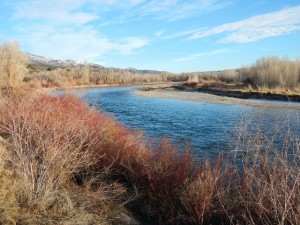South Fork Winter Fishing
We surely have been lucky to have such good warm weather recently, and it looks like more is to come during this second half of winter (Let’s hope summer isn’t correspondingly as warm!). All this means getting out to fish should be really enjoyable. Much of the South Fork, even around Swan Valley is free of ice and snow, now offers many locations for wading. Since February 6th flows out of Palisades Dam have been stepped up from around 900 cfs to around 2100 cfs today (February 10th). This change in flow should not have a major impact on fishing and certainly will not have a big impact on choosing a wading location. Water temps are around the mid thirties in degrees Fahrenheit, so don’t get in over those waders!
See that picture above? It was taken just above the far side of the Heise Bridge. Look at all the accessible river just in this view alone. There is good water in front of the far side gravel bar. And you cannot see it that well, but even better water is in the upstream bend with another gravel bar giving easy access. That is typical along the river. The river road above Heise is passable with care, but close to motorized travel above where the road from Table Rock joins, and offers many places where you can get to the river to fish. For sure come springtime, all this accessible water such as we have now will not be available for wading.
If you want to enjoy top water fishing, midge emergences provide the most consistent action. Some will take place on sunny days, but densest activity takes seems to take place overcast days without wind (if that’s possible). Pack such as black or red zebra midges, high voltage midge pupa, and spent midge patterns. Don’t overlook those old favorites the Griffith’s gnat and the renegade. You can fish these on top or as an emerger just under the surface. Use all these in sizes about the same as the natural insect. Expect most of the action to take near or at the surface, so go with a floating line and long, fine leader. A downstream drift with a gentle rise of the rod tip when the fly reaches rising fish will bring strikes. Expect many of these to be from whitefish. If you prefer to present wet flies in deeper water golden stonefly nymph patterns are numerous, and each can be effective when drifted along riffles and into tops of runs and holes Try the same with rubber leg patterns. Usually a sink tip line allows the best presentation, but a full sink line can be used for fishing long slow runs. Try patterns that simulate an aquatic worm. San Juan worm and wooly bugger patterns are some of these. Another favorite technique for encountering bigger fish is presenting streamer patterns. Best time for presenting these is during low light conditions. That means early or late in the day and when overcast conditions prevail. Clouser minnow types are very effective and therefore popular, but small fly rod jigs work just as well during these times. Presenting feather wing streamers also have enthusiasts. Sink tip fly lines seem best for presenting streamers. Be sure to use a stout leader. And bring that camera!

